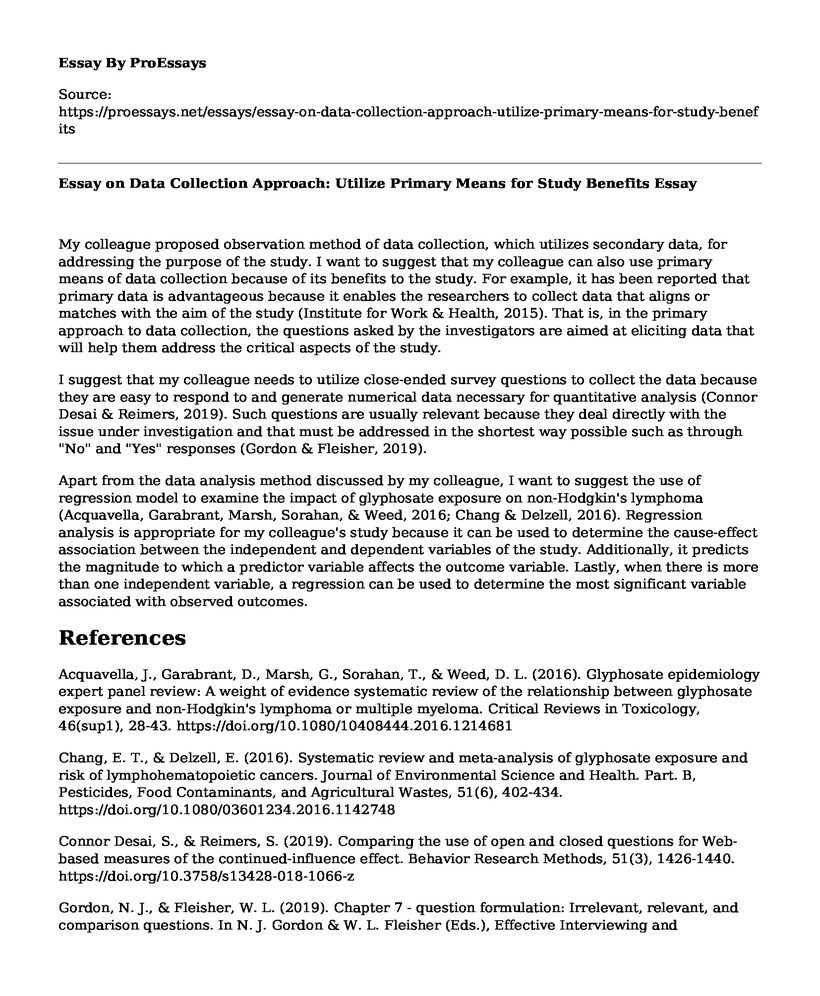My colleague proposed observation method of data collection, which utilizes secondary data, for addressing the purpose of the study. I want to suggest that my colleague can also use primary means of data collection because of its benefits to the study. For example, it has been reported that primary data is advantageous because it enables the researchers to collect data that aligns or matches with the aim of the study (Institute for Work & Health, 2015). That is, in the primary approach to data collection, the questions asked by the investigators are aimed at eliciting data that will help them address the critical aspects of the study.
I suggest that my colleague needs to utilize close-ended survey questions to collect the data because they are easy to respond to and generate numerical data necessary for quantitative analysis (Connor Desai & Reimers, 2019). Such questions are usually relevant because they deal directly with the issue under investigation and that must be addressed in the shortest way possible such as through "No" and "Yes" responses (Gordon & Fleisher, 2019).
Apart from the data analysis method discussed by my colleague, I want to suggest the use of regression model to examine the impact of glyphosate exposure on non-Hodgkin's lymphoma (Acquavella, Garabrant, Marsh, Sorahan, & Weed, 2016; Chang & Delzell, 2016). Regression analysis is appropriate for my colleague's study because it can be used to determine the cause-effect association between the independent and dependent variables of the study. Additionally, it predicts the magnitude to which a predictor variable affects the outcome variable. Lastly, when there is more than one independent variable, a regression can be used to determine the most significant variable associated with observed outcomes.
References
Acquavella, J., Garabrant, D., Marsh, G., Sorahan, T., & Weed, D. L. (2016). Glyphosate epidemiology expert panel review: A weight of evidence systematic review of the relationship between glyphosate exposure and non-Hodgkin's lymphoma or multiple myeloma. Critical Reviews in Toxicology, 46(sup1), 28-43. https://doi.org/10.1080/10408444.2016.1214681
Chang, E. T., & Delzell, E. (2016). Systematic review and meta-analysis of glyphosate exposure and risk of lymphohematopoietic cancers. Journal of Environmental Science and Health. Part. B, Pesticides, Food Contaminants, and Agricultural Wastes, 51(6), 402-434. https://doi.org/10.1080/03601234.2016.1142748
Connor Desai, S., & Reimers, S. (2019). Comparing the use of open and closed questions for Web-based measures of the continued-influence effect. Behavior Research Methods, 51(3), 1426-1440. https://doi.org/10.3758/s13428-018-1066-z
Gordon, N. J., & Fleisher, W. L. (2019). Chapter 7 - question formulation: Irrelevant, relevant, and comparison questions. In N. J. Gordon & W. L. Fleisher (Eds.), Effective Interviewing and Interrogation Techniques (Fourth Edition) (pp. 87-93). Academic Press. https://doi.org/10.1016/B978-0-08-102610-6.00007-7
Institute for Work & Health. (2015). Primary data and secondary data. Retrieved https://www.iwh.on.ca/what-researchers-mean-by/primary-data-and-secondary-data
Cite this page
Essay on Data Collection Approach: Utilize Primary Means for Study Benefits. (2023, Mar 26). Retrieved from https://proessays.net/essays/essay-on-data-collection-approach-utilize-primary-means-for-study-benefits
If you are the original author of this essay and no longer wish to have it published on the ProEssays website, please click below to request its removal:
- The Shell Company SWOT Analysis
- Visual Data Exploration Essay
- Quantitative Research Investigation Paper Example
- A Qualitative Data Collection Method Needed to Determine the Source of the Outbreak
- The Extent to Which Mixed Methods Research Combine Quantitative and Qualitative Design
- Indigenous Research Methodology: Gluskabe's Encounters with Epistemicide: Article Analysis Essay
- Quantitative & Qualitative Research in Analysis & Modeling of Spectacles - Essay Sample







